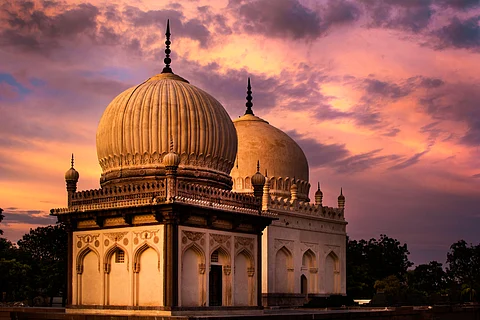
- Destinations
- Experiences
- Stay
- What's new
- Celebrating People
- Responsible Tourism
- CampaignsCampaigns
- SubscribeSubscribe
- Buy Now

In Hyderabad, nestled in the tranquility of Ibrahim Bagh, only a few furlongs from the iconic Golconda Fort, are the magnificent Qutb Shahi Tombs. These tombs are the living testament to the grandeur of the Qutb Shahi dynasty that ruled the Deccan from 1518 to 1687. The sprawling necropolis, encompassing over 100 monuments, acts as a window into the architectural prowess, respect for the dead, and the cultural portmanteau of Persian, Indian and Deccani styles that this period witnessed. The whole sanctuary is recognised for its historical significance and was added to the UNESCO's Tentative List in 2014 under the "Monuments and Forts of the Deccan Sultanate." Today, we take a brief stroll in this relic of the past and the dead, and find out all that is of interest to a traveller steeped in history, heritage and Hyderabad.
The Qutb Shahi Tombs in Hyderabad serve as the final resting site for the rulers of the Qutb Shahi dynasty, their family members and close associates. Initiated by Sultan Quli Qutb-ul-Mulk in 1543, the complex evolved over the 16th and 17th centuries, reflecting the dynasty's commitment to architectural excellence and cultural syncretism. Each tomb in this complex, if looked at closely, narrates the tales of power, art and devotion, turning the site into a rich repository of history and the dynastic rule in the Deccan.
The tombs are remarkable in their distinctive Indo-Islamic style. Constructed primarily from grey granite, the structures feature intricately carved stonework, pointed arches and large, and bulbous domes that were once adorned with blue and green tiles, the remnants of which still exist today and can be noticed on keen perusal.
The larger tombs, reserved for the high dignitaries and estimable personalities, are two-storied whereas the smaller ones are single-storied, each housing a sarcophagus that overlies the actual burial vault in a crypt below. Golden spires were fitted atop the tombs of the sultans to distinguish them from those of other royal family members.
Once inside the massive Qutb Shahi Tombs complex, a traveller can find much more than royal mausoleums. The site is laden with various other structures that include a mosque built by Sultan Quli Qutb Shah. Even today, the one that is considered one of the earliest Qutb Shahi structures is preserved in good shape.
There are also several step-wells and a traditional hammam (bathhouse) that is believed to have been in use by the royals for their ritual ablutions. The site once housed gardens inspired by the classic Persian Charbagh layout, and traces of it still survive. A mortuary bath also stands in the premises with intricate paving, stucco ornamentation, and restored pavilions that further add to enhance the grandeur.
The tombs were neglected and deteriorated over the decades. But in 2013, the Aga Khan Trust for Culture, along with the Telangana State Archaeology and Museums Department, started a major restoration project. The goal of this 10-year project was to improve the visitor experience while maintaining the site's architectural integrity. In order to preserve the tombs' legacy for upcoming generations, the restoration process involved landscape development, structural repairs, and the preservation of ornamental components.
The Qutb Shahi Tombs, in addition to their architectural grandeur, offer insights into the Deccan Sultanate's societal fabric. The layout of the site, the fusion of artistic styles, and the Arabic and Persian inscriptions reveal the dynasty's worldview. Scheduled educational tours and history walks teach visitors more about the site's historical significance.
The Qutub Shahi Tombs are located in Ibrahim Bagh, Hyderabad, Telangana.
The iconic Golconda Fort is roughly two kms away.
The Qutub Shahi Tombs are open on all days of the week from 9:30 AM to 5:30 PM.
Indian nationals need to pay INR 5, while foreign nationals needs to pay INR 100.
October to March, when the weather is pleasant.
